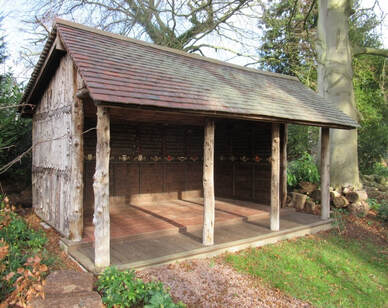In 1836 the house, originally known as the Dell was built at the same time as St Peters church on 2 acres of land bought for the purpose from the local landowner. The Dell which gave the house it's name is a former brick quarry now in the garden of another house. The second rector, Francis Hopkinson bought additional land and the garden which provides the framework for what we have today was laid out in the early 1860s, soon after he bought the house. There are later references to the garden being 10 acres, but we think that was probably dubious marketing!
According to a report of the Malvern Field Club 1942, the garden was planted under the supervision of Sir William Jackson Hooker (1795 – 1865). He was director of Kew Gardens during the time they were greatly extended, a sponsor of plant-hunting expeditions, and life-long friend and supporter of Darwin who lived nearby in Malvern Wells. The garden was planted with exotics like the Wellingtonia redwood (Sequoiadendron gigantia), Strawberry Trees (Arbutus unedo) and Acers, as well as Yews, Holm Oaks, Copper and European Beeches which form the structure of the garden you see today. remain today. The Field Club report mentions a Tulip tree (Liriodendron tulipifera) and Monkey Puzzle trees. Only the trunk of the Tulip tree remains, but it is the home of two of the carvings we've put in.
A major early feature of the garden was the summerhouse, originally looking over a croquet lawn. The inside walls and ceiling were decorated by Francis Hopkinson , who had a scholarly interest in history and heraldry, artistic skill and clearly ample leisure time! A major feature on the walls is a beautifully lettered extract from John Milton’s poem “L’Allegro”, accompanied by many other short quotations and epigrams from other sources. Even more amazing is a display of the names and coats of arms of all the Worcestershire landholders mentioned in the Doomsday Book (28 in all), of the signatories of the Magna Carta (25), and of many of the local landed families from more recent times, making a total of nearly one hundred references, all meticulously painted. The ceiling is covered by a hand-painted map of the surrounding area.
The Dell remained a family home until 1938, and although we do not believe children were ever brought up here, they obviously visited often enough to justify a Wendy House. We believe it was build around the 1920s, rumour has it by a former knife-and-boot boy from the Dell, risen in later life to the position of master builder.
A garden pavilion was added in 1930 and is signed by the original builders. We reroofed it in 2016. Kevin carved the replacement pinnacles, the dice incorporated into them reflecting our board gaming interest.
A garden pavilion was added in 1930 and is signed by the original builders. We reroofed it in 2016. Kevin carved the replacement pinnacles, the dice incorporated into them reflecting our board gaming interest.
We believe that the garden was well maintained when the house was know as the Dell Hydro and then the Dell Hotel. Publicity referred to "Ten Acres of beautiful gardens and wooded walks", and the dell was then an ornamental lake. We have found no evidence that the garden was ever ten acres, and suspect this was generous marketing.
We suspect the garden became more run down when the house was Lucidor House of Healing in the 1950s. In the 1960s it was used as a hostel for the Birmingham Society in Aid of Nervous Children. Around this time substantial parts of the garden were sold off and our guess is that the rest was by then seriously overgrown.
The Thurlow family bought the Dell House in 1972. Initially they bought only the area surrounding the house, as much of the rest had been sold off for houses. They bought back what they could, resulting in the rather odd shape 2 acre garden we now have.
We suspect the garden became more run down when the house was Lucidor House of Healing in the 1950s. In the 1960s it was used as a hostel for the Birmingham Society in Aid of Nervous Children. Around this time substantial parts of the garden were sold off and our guess is that the rest was by then seriously overgrown.
The Thurlow family bought the Dell House in 1972. Initially they bought only the area surrounding the house, as much of the rest had been sold off for houses. They bought back what they could, resulting in the rather odd shape 2 acre garden we now have.
Having bought more garden than they intended, the Thurlows did much restoration of it, quite probably the last people to do much with the garden until we arrived. Under their ownership the paintings in the summerhouse were carefully restored by a local artist and historian.
The house was converted to holiday accommodation in the 1980s. The garden was not 'part of the package' as it is now. In 2001 the summer house was moved to its present position by the car park. Apparently woodworm, wet rot and a damp location caused considerable deterioration to the fabric of the building. So it was carefully dismantled, renovated and rebuilt in its new position.
The garden in 2007 and 2012
By the time we bought the house in 2014 it was well overgrown.











